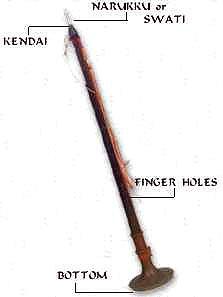Types: There are two varieties of Nagaswaram:
-
Timiri, which is shorter (usually about one and a half feet) and higher in pitch.
-
Bari, which is longer (two or two and a half feet) and lower in pitch.
Construction: The Nagaswaram is a double reed instrument with a conical bore that gradually enlarges towards the lower end. It is usually made of a type of seasoned ebony, although there are Nagaswarams made of sandalwood, redwood, silver, gold, etc. The top portion consists of a metal staple (called mel anaichu) and into this is inserted a small metallic cylinder called kendai. The kendai carries the mouthpiece, seevali, which is made of reed. Along with spare reeds, a small needle, known as kuchchi, made of ivory or horn, is attached to the Nagaswaram. The needle is used to clear the mouth-hole of saliva particles and allow air to pass through. The bottom is decorated with a metallic bell called the keezh anaichu.

Tuning: The standard Nagaswaram, Bari, which is commonly used today is usually set between 2 and 3 (D and E).
Playing technique: The Nagaswaram has seven finger-holes. There are 5 additional holes drilled at the bottom, which are used as controllers. Like the flute, the Nagaswaram has a range of two and a half octaves and the fingering techniques are similar. While in the flute, semi and quarter notes are produced by the partial opening and closing of the finger-holes, in the Nagaswaram, they are produced by varying the power of air blown into the pipe. This makes it a very strenuous instrument to play.